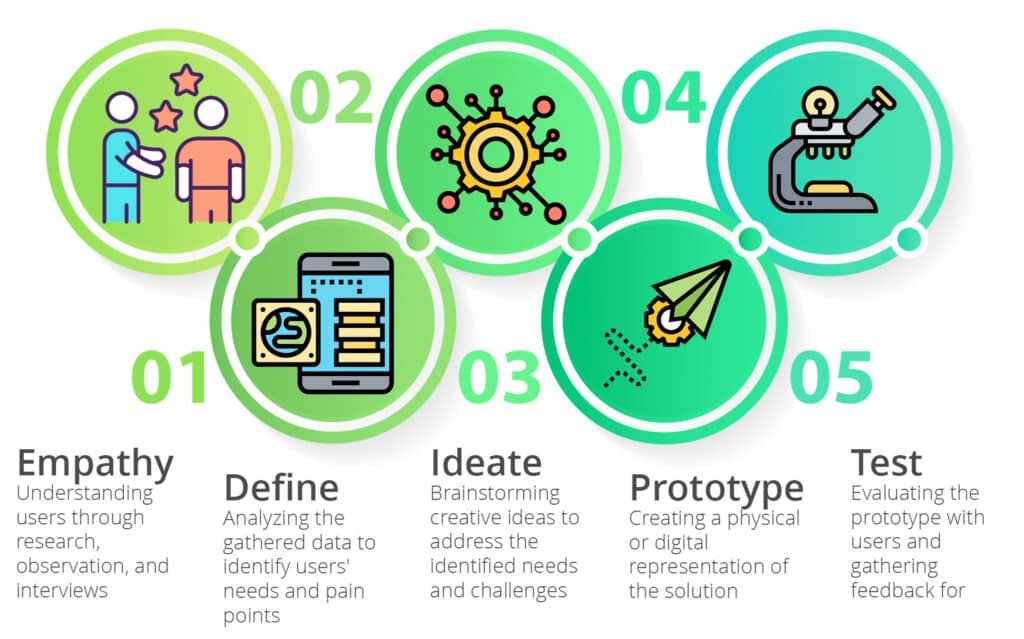What is Human-Centered Design?
Human-centered design focuses on understanding and empathizing with users to create tailored solutions. It values user perspective, making the final product functional and user-friendly. Designers using this method ensure their creations meet users’ needs genuinely. Emphasizing user understanding, empathy, and iteration refines the final product. A balance of research, ideation, prototyping, and testing makes human-centered design effective for creating innovative, user-friendly solutions.

Empathy: Understanding users through research, observation, and interviews
The empathy stage aims to gain a deep understanding of users’ experiences, needs, and motivations. This can involve various research methods such as interviews, observations, and surveys [1]. By engaging with users directly, designers can develop a more accurate understanding of their target audience, ultimately leading to more effective solutions. In this stage, it is crucial to remain open-minded and unbiased to ensure that the gathered insights truly reflect users’ perspectives and experiences [2].
Define: Analyzing the gathered data to identify users’ needs and pain points
During the define stage, engineers analyze the data collected in the empathy stage to identify patterns and trends, allowing them to pinpoint users’ needs and challenges [3]. This process often involves the creation of user personas, which are fictional representations of target users based on the collected data. These personas help designers to better understand and empathize with their target audience, ensuring that the design process remains focused on addressing users’ needs [4].
Ideate: Brainstorming creative ideas to address the identified needs and challenges
The ideate stage involves generating a wide range of potential solutions to address users’ needs. Engineers are encouraged to think creatively and consider unconventional ideas [5]. Techniques such as mind mapping, sketching, and brainstorming sessions can be employed to stimulate creative thinking and foster collaboration among team members. The goal of this stage is to explore as many ideas as possible, without limiting oneself to the most obvious or conventional solutions [6].
Prototype: Creating a physical or digital representation of the solution
In the prototype stage, engineers create a tangible representation of the proposed solution, such as a physical model, wireframe, or mock-up [7]. This helps to test and refine the design before investing significant resources in development. Prototypes can vary in their level of fidelity, ranging from simple sketches to more detailed and functional representations of the final product. The primary goal of this stage is to gather feedback on the design and identify any areas that may require further refinement or iteration [8].
Test: Evaluating the prototype with users and gathering feedback for refinement
The test stage involves presenting the prototype to users and gathering feedback on its performance, usability, and overall satisfaction [9]. This information is then used to refine the design and iterate the process. Testing with real users is crucial, as it allows designers to identify any unforeseen issues and make necessary adjustments to ensure that the final product truly meets users’ needs and expectations [10]. This iterative process of prototyping and testing helps to refine the design until it is ready for implementation.
References
[1] IDEO.org. (2015). The Field Guide to Human-Centered Design.
[2] Brown, T. (2008). Design Thinking. Harvard Business Review. https://hbr.org/2008/06/design-thinking
[3] Norman, D. A., & Draper, S. W. (1986). User Centered System Design; New Perspectives on Human-Computer Interaction. Lawrence Erlbaum Associates.
[4] Cooper, A., Reimann, R., & Cronin, D. (2007). About Face 3: The Essentials of Interaction Design. Wiley Publishing.
[5] Kelley, T., & Kelley, D. (2013). Creative Confidence: Unleashing the Creative Potential Within Us All. Crown Business.
[6] Michalko, M. (2006). Thinkertoys: A Handbook of Creative-Thinking Techniques. Ten Speed Press.
[7] Ries, E. (2011). The Lean Startup: How Today’s Entrepreneurs Use Continuous Innovation to Create Radically Successful Businesses. Crown Business.
[8] Preece, J., Rogers, Y., & Sharp, H. (2015). Interaction Design: Beyond Human-Computer Interaction (4th ed.). Wiley.
[9] Nielsen, J. (1993). Usability Engineering. Morgan Kaufmann. https://www.elsevier.com/books/usability-engineering/nielsen/978-0-12-518406-9
[10] Rubin, J., & Chisnell, D. (2008). Handbook of Usability Testing: How to Plan, Design, and Conduct Effective Tests (2nd ed.). Wiley Publishing. https://www.wiley.com/en-us/Handbook+of+Usability+Testing%3A+How+to+Plan%2C+Design%2C+and+Conduct+Effective+Tests%2C+2nd+Edition-p-9780470185483
Advantages of Human-Centered Design
Human-centered design (HCD) is a design methodology that places the user’s needs, preferences, and context at the center of the design process [1]. By adopting a human-centered design approach, engineers can enjoy several benefits, including enhanced user satisfaction, improved usability, increased adoption, reduced risk, and fostering innovation.
Enhanced User Satisfaction
Solutions designed with users in mind lead to higher satisfaction and a better overall experience. According to a study by the Nielsen Norman Group, projects employing user-centered design principles have a 66% higher return on investment (ROI) than projects without this focus [2]. By understanding the user’s context and addressing their pain points, engineers can create products that resonate with the target audience and keep them engaged.
Positive Word of Mouth
Satisfied users are more likely to recommend a product to their peers, generating positive word of mouth and increasing the overall success of the solution [3]. This organic growth can significantly reduce marketing costs and contribute to long-term brand loyalty.
Improved Usability
HCD focuses on making products and systems intuitive and easy to use, reducing the learning curve for users [4]. This can result in fewer user errors, increased efficiency, and a more pleasant experience overall.
Accessibility and Inclusivity
By considering a diverse range of users during the design process, HCD can lead to more accessible and inclusive products [5]. This not only ensures compliance with accessibility standards but also broadens the potential user base, making the solution available to a wider audience.
Increased Adoption
Users are more likely to adopt and recommend solutions that cater to their needs and preferences. A study by the Design Management Institute found that design-led companies outperformed the S&P 500 by 228% over a 10-year period [6]. By focusing on users’ needs and preferences, engineers can create solutions that gain traction and capture market share.
Reduced Risk
Involving users throughout the design process helps identify potential issues early, saving time and resources [7]. By iterating on designs based on user feedback, engineers can reduce the likelihood of costly redesigns or product failures after launch.
Higher Success Rates
Human-centered design has been shown to increase project success rates. According to a report by the Standish Group, projects that employed HCD principles had a 50% higher success rate than those that did not [8]. This can result in significant cost savings and a more efficient use of resources.
Fostering Innovation
HCD encourages creative problem-solving and can lead to unique and groundbreaking solutions. By focusing on users and their needs, engineers are challenged to think outside the box and come up with innovative ways to address the identified problems [9].
Competitive Advantage
In a rapidly changing market, companies that prioritize human-centered design can gain a competitive advantage by offering unique and innovative solutions that cater to the ever-evolving needs of their users [10].
References
[1] IDEO.org. (2015). The Field Guide to Human-Centered Design. Retrieved from
[2] Nielsen, J., & Norman, D. (2006). The ROI of Usability. Nielsen Norman Group. https://www.nngroup.com/articles/return-on-investment-for-usability/
[3] Szymanski, D. M., & Henard, D. H. (2001). Customer Satisfaction: A Meta-Analysis of the Empirical Evidence. Journal of the Academy of Marketing Science, 29(1), 16-35.
[4] ISO 9241-11:1998. (1998). Ergonomic requirements for office work with visual display terminals (VDTs) – Part 11: Guidance on usability. International Organization for Standardization. https://www.iso.org/standard/16883.html
[5] Vanderheiden, G. C., & Tobias, J. (2000). Universal Design of Consumer Products: Current Industry Practice and Prospects for the Future. Assistive Technology, 12(2), 87-95.
[6] Design Management Institute. (2015). The DMI Design Value Index: Design Value Matters. Retrieved from https://www.dmi.org/page/2015DVIandOTW
[7] Bødker, S., Kensing, F., & Simonsen, J. (2004). Participatory IT Design: Designing for Business and Workplace Realities. Cambridge, MA: MIT Press.
[8] The Standish Group. (2003). CHAOS Report. https://www.projectsmart.co.uk/white-papers/chaos-report.pdf
[9] Brown, T. (2009). Change by Design: How Design Thinking Transforms Organizations and Inspires Innovation. New York, NY: HarperCollins.
[10] Liedtka, J., & Ogilvie, T. (2011). Designing for Growth: A Design Thinking Toolkit for Managers. New York, NY: Columbia University Press.
When to Use Human-Centered Design
Human-centered design (HCD) is an approach that prioritizes the needs, desires, and behaviors of the end-users in the design and development of products, services, and systems (1). This method is valuable in various situations, such as when users’ needs are complex, usability is crucial, market differentiation is desired, and iterative development is necessary.
Complex or Poorly Understood User Needs: Uncovering Hidden Needs and Desires
In cases where users’ needs are complex or not well understood, human-centered design can help identify and address these requirements. Through research methods such as interviews, observations, and surveys, HCD helps uncover the users’ needs, desires, and pain points that may not be immediately apparent (2). This approach ensures that solutions are tailored to users’ specific requirements and can improve the overall user experience.
Usability is Crucial: Enhancing User Interaction and Engagement
For products, services, or systems that require a high degree of interaction or user engagement, HCD can significantly improve usability and user satisfaction. By incorporating user feedback throughout the design and development process, HCD ensures that the final product is easy to use, efficient, and enjoyable for the target audience (3). This focus on usability can lead to increased user retention, engagement, and overall satisfaction.
Market Differentiation: Creating Unique and Competitive Products
In competitive markets, businesses may seek to differentiate their products or services from their rivals. Human-centered design can help companies create unique solutions that address the specific needs and desires of their users (4). By understanding and addressing these unique requirements, HCD allows businesses to develop products and services that stand out from the competition, leading to a competitive advantage and increased market share.
Iterative Development: Embracing Prototyping and Testing
Projects that require multiple iterations and refinements benefit significantly from human-centered design. HCD emphasizes the importance of prototyping, testing, and iterating on designs based on user feedback (5). This iterative process allows designers and developers to identify and fix issues early in the development cycle, ensuring that the final product is refined, user-friendly, and aligned with users’ needs and expectations.
References
- Norman, D. A., & Draper, S. W. (1986). User-Centered System Design: New Perspectives on Human-Computer Interaction. Lawrence Erlbaum Associates.
- IDEO. (2015). The Field Guide to Human-Centered Design. IDEO. Retrieved from
- Nielsen, J. (1993). Usability Engineering. Morgan Kaufmann.
- Brown, T. (2009). Change by Design: How Design Thinking Transforms Organizations and Inspires Innovation. HarperBusiness.
- Schuler, D., & Namioka, A. (Eds.). (1993). Participatory Design: Principles and Practices. CRC Press.
Situations Where Human-Centered Design Might Not Be Effective
Human-centered design (HCD) is a problem-solving approach that focuses on understanding and addressing the needs and desires of users. While HCD can be a powerful tool for addressing complex problems, there are situations where it may not be the most effective approach. Technical constraints, infrastructure or system-level problems, short development timelines, regulatory compliance, and low user interaction are some of the situations where HCD may not be suitable.
Technical Constraints
HCD relies on gathering user feedback and using that feedback to inform design decisions. However, in some engineering projects, there may be strict technical constraints or limitations that make it difficult to incorporate user feedback. For example, in aerospace engineering, safety regulations and technical requirements are crucial, and HCD may not provide enough focus on the feasibility of proposed solutions. In such cases, an approach that combines technical expertise with user-centered design may be more effective.
Infrastructure or System-Level Problems
HCD’s focus on individual users may not be the most effective way to address problems that require a broader, systemic approach. In some cases, infrastructure or system-level problems require a more comprehensive approach that considers the entire ecosystem of users, processes, and technology. For example, addressing systemic issues related to climate change or improving access to healthcare may require a more extensive approach that goes beyond individual user needs.
Short Development Timelines
The iterative nature of HCD can be time-consuming, making it less suitable for projects with tight deadlines or limited resources for research and user testing. In some cases, companies or organizations may need to prioritize speed to market or cost-effectiveness over user-centered design. For example, in the fast-paced technology industry, companies may need to launch products quickly to remain competitive, which may not allow for extensive user testing and iteration.
Regulatory Compliance
In some industries, there are strict regulations or standards that must be met, which can conflict with the focus on user needs and desires. For example, in healthcare, regulatory compliance and patient safety are paramount, and HCD may not be the most effective approach in cases where there are strict regulations that must be followed. In such cases, an approach that balances regulatory compliance and user needs may be more appropriate.
Low User Interaction
HCD is most effective when designing products or systems with significant user interaction or where user preferences have a significant impact on the design. However, in some cases, products or systems may have minimal user interaction or where user preferences have little impact on the design. For example, designing a bridge or developing software that runs in the background of a computer system may not require a user-centered design approach.
References
- Ulrich, K. T., & Eppinger, S. D. (2017). Product design and development. McGraw-Hill Education.
- Norman, D. A. (2013). The design of everyday things: Revised and expanded edition. Basic Books.
- Liedtka, J. (2015). Perspective: Linking design thinking with innovation outcomes through cognitive bias reduction. Journal of Product Innovation Management, 32(6), 925-938. https://doi.org/10.1111/jpim.12234
Human-Centered Design | Technology-Centered Design | |
|---|---|---|
| Approach | Emphasizes the needs, preferences, and behaviors of end-users. | Emphasizes technical specifications and requirements. |
| Purpose | To create solutions that are tailored to the specific needs of users, and that provide a better overall experience. | To create solutions that meet technical specifications and requirements, and that are functional and efficient. |
| Process | Empathy, Define, Ideate, Prototype, Test | Problem Identification, Design, Implementation |
| Outcome | User satisfaction, usability, adoption, reduced risk, innovation | Technical functionality, efficiency, performance |
| Focus | End-users, their needs, desires, and behaviors. | Technical specifications, requirements, and constraints. |
| Advantages | Solutions that are more user-friendly, effective, and appealing. Higher user satisfaction, reduced risk, fosters innovation, and increased adoption. | Solutions that are functional, efficient, and meet technical requirements. |
| Disadvantages | May take more time and resources to develop, may not be suitable for projects with strict technical constraints, may not prioritize technical requirements or constraints, may not be as suitable for complex technical systems. | May not prioritize the user experience or user needs, may not be suitable for projects that require a high degree of user interaction or engagement. |
Case Studies: Human-Centered Design in Action
To further illustrate the benefits and application of human-centered design, we will explore a few case studies that showcase how HCD has been used to create innovative, user-friendly solutions across various industries.
Case Study 1: Healthcare – Designing a Better Patient Experience
A healthcare provider sought to improve the patient experience at their outpatient clinic, where patients often felt overwhelmed by the complexity of the environment and the information they received (21). Using human-centered design, the organization conducted in-depth interviews and shadowed patients to better understand their needs and pain points.
Based on their findings, they implemented several changes, such as redesigning the layout of the clinic for better navigation, creating more user-friendly appointment scheduling tools, and offering personalized care plans for patients. As a result, patient satisfaction scores increased significantly, and the clinic saw a reduction in missed appointments.
Case Study 2: Transportation – Enhancing Public Transit Accessibility
A public transit agency aimed to improve the accessibility of their services for passengers with disabilities (23). They used human-centered design principles to engage with passengers who had various disabilities, conducting interviews and observing their experiences while using the transit system.
By understanding the unique needs of these passengers, the agency was able to develop solutions such as redesigned boarding platforms, better signage and wayfinding, and enhanced staff training to assist passengers with disabilities. These changes led to a more inclusive and accessible transit experience for all users.
Case Study 3: Education – Creating a More Engaging Learning Environment
An educational institution wanted to redesign its learning spaces to foster collaboration and engagement among students. Utilizing human-centered design, the institution engaged with students and faculty to understand their needs, preferences, and challenges in the current learning environment.
The resulting design solutions included flexible seating arrangements, interactive whiteboards, and improved acoustics. These changes led to increased student engagement and collaboration, as well as higher satisfaction levels among both students and faculty.
Human-Centered Design in Engineering Education
Teaching engineering students human-centered design principles can ready them to tackle intricate real-world problems with a user-focused mindset. Placing users at the heart of the problem-solving process has the potential to transform how engineers approach their work. By comprehending and empathizing with users’ needs, preferences, and difficulties, engineers can devise pioneering and user-friendly solutions that boost adoption and satisfaction. Integrating human-centered design principles into engineering education readies upcoming engineers to approach real-world problems with a user-focused outlook.
Some strategies for integrating HCD into engineering curricula include:
Problem-based learning
In problem-based learning, students are presented with real-world problems and are encouraged to use human-centered design principles to develop solutions. This approach helps students develop empathy for users, practice collaboration, and enhance their problem-solving skills.
Interdisciplinary collaboration
Encouraging collaboration between engineering students and students from other disciplines, such as design, business, or social sciences, can foster a more comprehensive understanding of human-centered design principles and their application across various domains.
Hands-on projects and internships
Providing students with opportunities to work on real-world projects or internships where they can apply human-centered design principles can help them gain valuable experience and develop a user-centric mindset
Future of Human-Centered Design in Engineering
As tech grows and users’ demands become intricate, human-centered design gains importance in engineering. It gives engineers a powerful approach to problem-solving, prioritizing users’ needs and desires. By embracing HCD, engineers can design user-friendly products, services, and systems that are effective and appealing. HCD leads to innovative solutions that improve user satisfaction, increase adoption, and create positive impacts on society and the environment. By fostering a user-centric mindset and integrating HCD principles, engineers can unleash their potential and spur innovation in their fields.
The future of HCD in engineering may include:
Integration with emerging technologies
As emerging technologies such as artificial intelligence, virtual reality, and the Internet of Things (IoT) become more prominent, engineers will need to integrate human-centered design principles to ensure these technologies cater to user needs and create positive user experiences.
Greater emphasis on sustainability and social impact
As environmental and social concerns continue to gain importance, engineers will need to adopt human-centered design principles that consider not only the immediate needs of users but also the long-term impacts on society and the environment.
Increased collaboration between disciplines
The future of human-centered design in engineering will likely involve greater collaboration between engineers and professionals from other fields, such as psychology, anthropology, and design. This interdisciplinary approach will help engineers better understand the complex needs of users and create more innovative and holistic solutions.
Evolving design methodologies
As human-centered design continues to evolve, new methodologies and tools may emerge to help engineers more effectively engage with users and create tailored solutions. This evolution will require engineers to stay up-to-date with the latest advancements in HCD and adapt their approaches accordingly.
Overcoming Challenges in Implementing Human-Centered Design
While human-centered design offers significant benefits for engineers, it is not without its challenges. To successfully implement HCD, engineers and organizations must be prepared to address these potential obstacles:
Organizational culture and mindset
Adopting human-centered design principles often requires a shift in organizational culture and mindset. Engineers and organizations must be open to embracing empathy, collaboration, and an iterative approach to problem-solving, which may differ from traditional engineering practices.
Resource constraints
Implementing human-centered design can be resource-intensive, as it involves conducting user research, prototyping, and testing. Organizations must be prepared to invest time, effort, and resources in these activities to fully realize the benefits of HCD.
Resistance to change
As with any change in approach or methodology, there may be resistance from team members or stakeholders who are more comfortable with traditional engineering practices. It is crucial to effectively communicate the benefits of human-centered design and demonstrate its value through successful implementation.
Balancing user needs with technical feasibility
While human-centered design places a strong emphasis on user needs, engineers must also consider technical feasibility and constraints. Striking the right balance between user needs and technical considerations is critical to the success of HCD-driven projects.
Strategies for Successful Implementation of Human-Centered Design
To overcome the challenges associated with implementing human-centered design in engineering projects, organizations can adopt the following strategies:
Foster a culture of empathy and collaboration
Encourage team members to develop empathy for users by engaging in user research, observation, and interviews. Promote collaboration between engineers and other disciplines to ensure a comprehensive understanding of user needs and a more holistic approach to problem-solving.
Provide training and resources
To successfully integrate human-centered design into their projects, engineers and organizations need to invest in training and resources that provide them with the necessary skills and tools. This may involve attending workshops, seminars, or seeking external experts and resources. By addressing these challenges and implementing the strategies outlined, engineers can create more innovative, user-centric solutions that lead to higher user satisfaction and adoption rates.
Develop a structured HCD process
Create a structured process for implementing human-centered design principles in engineering projects, including clear guidelines for user research, prototyping, and testing. This will help ensure that HCD principles are consistently and effectively applied across projects.
Establish success metrics
Establish clear success metrics for human-centered design implementation, such as user satisfaction, adoption rates, and usability improvements. These metrics can help demonstrate the value of HCD and encourage continued investment in the approach.
Engage stakeholders
Engage stakeholders throughout the HCD process, including users, team members, and decision-makers, to ensure buy-in and support for the approach. This engagement can help overcome resistance to change and facilitate the successful adoption of human-centered design principles.
Adapting Human-Centered Design for Different Industries
While human-centered design principles can be applied across various industries, the specific needs and context of each industry may require adaptation of the HCD approach. Below are some examples of how human-centered design can be tailored to suit different industries:
Automotive Industry
In the automotive industry, engineers must consider factors such as safety, fuel efficiency, and performance, along with user preferences and comfort. Human-centered design can be applied to enhance the driving experience by focusing on ergonomics, intuitive controls, and user-friendly interfaces while ensuring that these improvements do not compromise safety or performance.
Energy Industry
In the energy industry, engineers must balance the needs of users with environmental sustainability and cost-effectiveness. Human-centered design can help engineers create solutions that optimize energy consumption, minimize environmental impact, and address users’ preferences for comfort and convenience.
Consumer Electronics
In the consumer electronics industry, engineers must consider factors such as usability, aesthetics, and functionality when designing products. Human-centered design can be used to create devices that are not only visually appealing but also easy to use, understand, and maintain, leading to higher user satisfaction and adoption.
Aerospace Industry
In the aerospace industry, engineers must prioritize safety, reliability, and efficiency while meeting the needs of users such as pilots, crew, and passengers. Human-centered design can be applied to create more user-friendly cockpit interfaces, improve cabin comfort and amenities, and enhance communication systems, all while maintaining strict safety and performance standards.
Construction Industry
In the construction industry, engineers must consider factors such as safety, durability, and cost-effectiveness while meeting the needs of users and occupants. Human-centered design can be applied to create spaces that are not only safe and functional but also promote well-being, productivity, and a sense of community among occupants.
Collaboration Between Engineers and Designers
Collaboration between engineers and designers is crucial for the successful implementation of human-centered design. By combining their expertise and perspectives, these professionals can create innovative solutions that are centered around the user. This collaborative approach can unlock the full potential of human-centered design, leading to more user-centric solutions that drive satisfaction and adoption across various industries.
Some strategies for fostering collaboration between engineers and designers include:
Cross-disciplinary teams
Form cross-disciplinary teams that include engineers, designers, and other relevant professionals. This allows for a more comprehensive understanding of user needs, technical constraints, and design possibilities, leading to more effective solutions.
Joint workshops and brainstorming sessions
Organize joint workshops and brainstorming sessions where engineers and designers can share their ideas, knowledge, and perspectives. This collaborative approach can help generate more innovative ideas and foster a shared understanding of the project goals and constraints.
Collaborative prototyping and testing
Encourage engineers and designers to work together on prototyping and testing, allowing for iterative refinement of the solution based on both user feedback and technical considerations. This collaboration can help ensure that the final solution is both user-friendly and technically feasible.
Shared success metrics
Establish shared success metrics for the project that take into account both user satisfaction and technical performance. This will help align the goals and priorities of engineers and designers, fostering a collaborative approach to problem-solving.
Case Studies: Successful Implementation of Human-Centered Design in Engineering
Human-centered design is a problem-solving approach that prioritizes the needs and preferences of users in the engineering process. It enables engineers to create products, services, and systems that are more user-friendly, effective, and appealing. However, successfully implementing human-centered design can be challenging due to factors such as organizational culture, resource constraints, and resistance to change. Overcoming these challenges requires fostering a culture of empathy and collaboration, providing training and resources, and engaging stakeholders. Real-world case studies demonstrate the transformative power of human-centered design in creating innovative, user-centric solutions that improve user satisfaction and drive adoption. By embracing human-centered design principles and fostering collaboration between engineers and designers, the engineering profession can continue to evolve and meet the complex needs of users and society as a whole.
Below are some real-world case studies where HCD principles have been successfully applied:
Apple’s iPhone
The iPhone is a classic example of human-centered design in action. Apple focused on creating a device that was intuitive, user-friendly, and aesthetically pleasing, leading to a product that revolutionized the smartphone industry. By prioritizing user needs and desires, Apple created a product that offered a seamless user experience and set a new standard for smartphone design.
IDEO’s Embrace Infant Warmer
IDEO, a global design company, used human-centered design principles to develop the Embrace Infant Warmer, a low-cost, portable solution for keeping premature and low-birth-weight infants warm in developing countries. By engaging with healthcare professionals, parents, and other stakeholders, IDEO identified the specific needs and constraints of the target users, leading to a product that has saved thousands of lives and garnered international recognition.
Tesla’s Electric Vehicles
Tesla has become a leader in the electric vehicle industry by focusing on human-centered design principles. Their vehicles combine cutting-edge technology with user-friendly interfaces, sleek aesthetics, and a focus on sustainability, addressing the needs and desires of environmentally-conscious drivers. Tesla’s commitment to HCD has led to widespread adoption and brand loyalty among consumers.
Philips’ Ambient Experience for Healthcare
Philips used human-centered design principles to develop the Ambient Experience, an innovative approach to healthcare environments that integrates technology, design, and architecture to create a more comfortable and soothing experience for patients. By focusing on the needs and desires of patients and healthcare providers, Philips has created a solution that improves patient satisfaction, reduces stress, and enhances the overall healthcare experience.






